Content Overview
The Journey of Paraffin: Unraveling the Paraffin Wax Production Process
Unveiling the paraffin wax production process offers a glimpse into a crucial industry that impacts a myriad of sectors, from cosmetics and food to packaging and candle-making. This intricate process, originating from crude oil, goes through a number of refining steps to yield the versatile paraffin wax. In this piece, we explore this journey, providing a comprehensive overview of the science, technology, and data that power it.
Understanding the Basics: Crude Oil to Paraffin Wax
Crude oil, a naturally occurring fossil fuel, is the starting point in the production of paraffin wax. It’s a complex mixture of hydrocarbons, and its refining process results in a wide array of products, including gasoline, diesel, jet fuel, and of course, paraffin wax.
The refining process essentially involves separating the crude oil into its component hydrocarbons based on their boiling points—a procedure known as fractional distillation. The heavy residuals left after this process, often termed as ‘slack wax,’ are the precursor to paraffin wax.
Unveiling the Paraffin Wax Production Process
Once the slack wax is obtained, it undergoes a series of processes to become paraffin wax. These processes include:
Dewaxing: This process involves cooling the slack wax, leading to the crystallization of the wax content. The crystallized wax is then separated using a filtration or centrifugation process.
Hydrofinishing or Hydrotreating: The dewaxed oil is treated with hydrogen in the presence of a catalyst to remove impurities and enhance the stability and quality of the wax.
Bleaching: This process helps in the removal of color and any remaining impurities. The wax is mixed with activated bleaching earth or clay, then filtered to give a clear wax.
Hardening: Depending on the desired product, the wax can be further treated to modify its hardness and melting point.
Scientific Aspects and Statistics
The scientific principles governing the paraffin wax production process are rooted in the field of physical chemistry. The refinement and separation techniques are based on the differences in physical properties, such as boiling point and solubility, among the various components of crude oil.
Statistically, the paraffin wax market has been witnessing a steady growth due to its wide-ranging applications. According to industry reports, the global paraffin wax market size was valued at USD 4.87 billion in 2021 and is projected to reach USD 6.4 billion by 2025, growing at a CAGR of 3.7%.
A Sustainable Approach: Recycling Paraffin Wax
In the era of sustainable practices, the recycling of paraffin wax has gained momentum. Used paraffin wax can be collected, melted, filtered, and then reprocessed to yield reusable wax. This not only conserves resources but also significantly reduces the environmental impact of wax disposal.
Global Impact and Market Trends
The global footprint of the paraffin wax industry is quite impressive, with Asia-Pacific leading the market share due to its booming cosmetics and packaging industries. Europe and North America follow closely, driven by robust demand in the food industry and candle making.
While the paraffin wax production process remains relatively consistent, market trends heavily influence the industry. Demand for scented and specialty candles, eco-friendly food packaging, and high-quality cosmetics are some of the trends driving innovation in paraffin wax production.
Key Challenges and Future Prospects
Despite the industry’s success, it faces challenges. Fluctuations in crude oil prices directly impact paraffin wax costs, causing market instability. Additionally, the environmental concerns associated with fossil fuel extraction and usage pose a significant challenge.
Nevertheless, innovations in wax recycling and the development of eco-friendly wax alternatives paint a promising future for this industry. The increasing demand for paraffin wax in emerging sectors like rubber, adhesive, and board sizing also opens new avenues for growth.
Conclusion: The Enduring Significance of Paraffin Wax Production
Understanding the paraffin wax production process offers valuable insights into a critical industry that influences a broad range of sectors. As we’ve explored, this journey from crude oil to paraffin wax is not only scientifically intriguing but also economically significant. Despite challenges, the future of paraffin wax production remains bright, backed by technological advancements, sustainable practices, and emerging market opportunities.
From being a humble ingredient in candle-making to becoming an indispensable component in various industries, paraffin wax’s journey is indeed remarkable. And it all begins with the fascinating paraffin wax production process.
Purchasing This Product from Petro Naft
For more detailed information and to purchase the product discussed in this article, please visit the dedicated product page below. Alternatively, use the various communication channels provided on our site to register your purchase inquiry or take advantage of our expert guidance.
Prepared by the PetroNaft Co. research team.

